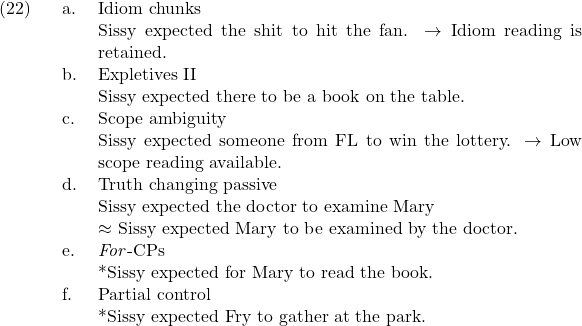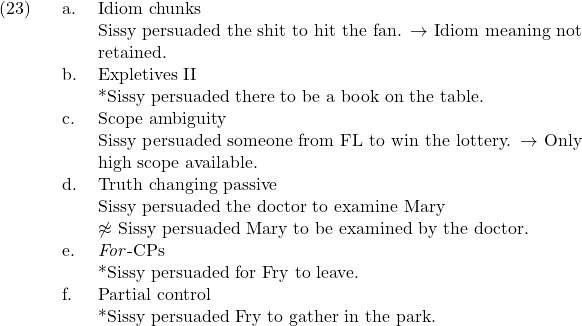11 Raising versus Control
Learning Objectives
By the end of this chapter, you should,
- be able to identify raising and control predicates using the diagnostics listed below
- understand the structural difference between raising/control verbs, and be able to structural represent that difference
- appreciate the arguments and evidence for PRO, and how it differs from pro.
We now know that spec-TP is empty at D-structure, and that subjects raise to spec-TP from where they are selected. This chapter addresses further issues in phrasal movement. We will mainly be concerned with the similarities and differences between the following sentences.
![]()
The sentences of course mean different things. But they consist of the same linear sequence of words. A subject (Khufu), a finite verb (seems/wants), a nonfinite verb (to run) and an adverb (fast). The sole difference is the finite verb. In (1a), the verb is seems and in (1b) the verb is wants.
Despite the surface similarities, we’ll discover in this chapter that the two sentences have wildly different syntactic structures, all of which are related to the following core difference:
That is, want c-selects for a subject and assigns it a thematic role. Khufu in (1b) is an argument of want and gets the thematic role Experiencer. Seem on the other does not select for a subject and does not assign it a thematic role. Instead, in (1a), Khufu is selected by the infinitive and “raises” into the main clause from the lower clause.
The difference between the two verbs is sketched below. We’ll provide a more precise analysis later. The important thing to keep in mind is the starting place of the subject. For verbs like seem, the subject starts inside of the lower clause. For verbs like want, the subject starts outside of the lower clause.

We call predicates like seem raising verbs, and we call predicates like want control verbs.
All of the following diagnostics illustrate this same difference: that the starting place of the subject of a raising verb is different than the starting place of the subject of a control verb.
Note that while the data is given in English, these diagnostics have cross-linguistic validity. All else equal, you can use these diagnostics to determine whether a verb embedding a nonfinite clause belongs to the class of raising or control verbs.
Raising vs. control
All of the following diagnostics allow you to determine if something is a raising or a control verb. To apply the diagnostic, you mechanically use the data given.
Expletives subjects I.
Raising verbs often permit an alternation between a referential subject and an expletive subject. Control verbs don’t.
![]()
How do we know that it in (4a) is an expletive? Well, it doesn’t appear to have semantic content. It doesn’t refer to anything. For instance, you can’t ask the question, *What seems that Khufu runs fast?
These data support the idea that seem doesn’t s-select for a subject, because that position can be filled by a semantically “vacuous” element.
Note that many languages don’t (obviously) have expletive subjects. For instance, in pro-drop languages like Spanish and Swahili, the subject position is obligatorily empty.

Again, this supports the idea that such sentences involve a semantically empty subject, since it cannot be referred to using an overt pronoun.
How to apply the expletive subject test
- Start with you original sentence → Khufu seems to run fast
- Replace the subject with an expletive, and make the lower clause finite → It seems that Khufu runs fast.
- Check the grammaticality. If it’s grammatical, the verb is a raising verb.
Expletives I (length: 55s) credit: Keira Dobbs
It is worth asking why there are expletive subjects at all. They don’t appear to serve a semantic purpose—that is, they don’t mean anything. So why do expletive subjects exist?
This is a complex question, and there are many ways to answer it. But one thing we can say is that, though expletive subjects do not serve a semantic function, they do serve a syntactic function, namely, the Subject Condition. If there is nothing else that can filled spec-TP, then an expletive subject is inserted. The following are examples of other types of expletive subjects in English.

Idiom chunks.
Some phrases are “non-compositional” in that the meaning isn’t predictable from the parts. These are called idioms or idiom chunks.
![]()
We find a distinction between raising and control verbs with respect to idiom chunks.

What we observe is that with raising verbs, the idiom meaning is retained. With control verbs it isn’t. The a. examples sound acceptable because we can interpret the entire idiom chunk together. The control verbs lose the idiomatic meaning because the subject is actually a subject of the higher verb.
Note that this diagnostic is concerned with interpretation. If we get the non-literal (idiomatic) reading after inserting the verb – as we do in (9a) and (10a) – then we conclude that the subject must have raised from the lower clause, as this is where the rest of the material from the idiomatic expression resides. This same idea explains why the idiomatic meaning is not retained with control verbs; the subject the cat in (9b) can only be interpreted as an actual animal that wants out of a bag (literal reading) because it was never in the lower clause, and therefore cannot be interpreted with the idiomatic material.
Applying the idiom chunk test
- Choose your favorite idiom → The shit hit the fan.
- Take the predicate you want to test (seem) and put it in the idiom → The shit seems to have hit the fan
- Check whether the idiom meaning is retained. You’re not looking for (un)grammaticality, rather you’re looking for whether the idiom meaning survives. If the idiom meaning survives, then it’s a raising verb.
Idiom test (length: 2m 49s) credit: Alesha Pisciotta
Idiom test (length: 1m 1s) credit: Keira Dobbs
Expletive subjects II.
English has another expletive subject, there. It’s only possible to use expletive there with a particular class of verbs, namely, verbs which assert existence, like the copula be.
![]()
Again we see a distinction between raising and control verbs with respect to expletive there.
![]()
The explanation behind this data goes as follows. Expletive there must be selected for by a particular predicate. Its appearance in (12a) follows because it has been selected for by the infinitive be in the lower clause. The reason it cannot appear in (12b) is that want cannot select for there.
Applying the expletive subject II test
- Take an existential sentence → There is a book on the table.
- Put the predicate you’re testing (seem) into the sentence → There seems to be a book on the table.
- Check the grammaticality. If it’s grammatical, then it’s a raising verb.
Expletive subjects II (length: 1m 22s) Credit: Megan Spurgeon
Truth changing passive.
If you passivize the infinitive under a raising verb, it basically means the same as the active version. If you passivize the infinitive under a control structure, it means something very different.

Here again the explanation is that the subject of seem “inherits” whatever thematic role is assigned to the subject of the passivized verb. But the subject of want gets its own thematic role.
Applying the passivization test
- Choose a sentence with a transitive verb → The doctor examined Mary.
- Put the predicate you’re testing (seem) in the sentence → The doctor seems to have examined Mary
- Passivize your original sentence → Mary was examined by the doctor
- Put the predicate you’re testing (seem) in the sentence → Mary seems to have been examined by the doctor
- Check whether the two sentences you’ve created meaning the same thing → The doctor seems to have examined Mary = Mary seems to have been examined by the doctor. If the sentences are interchangeable, then it’s a raising verb.
Passivization (Alesha Pisciotta; length: 3m 20s)
The final two tests below pick out only a subset of control verbs. Thus, if they pass, then you can confidently conclude that you have a control predicate. If they fail, you can conclude nothing.
For-CPs
Some control predicates allow both subject positions to be explicitly filled. The subject of the infinitive appears in front of the complementizer for.
![]()
Applying the for-CP test
- Make a sentence with the predicate you’re testing (wish) → Chi wishes to leave
- Add a subject in the lower clause after for → Chi wishes for Drey to leave.
- Check the grammaticality. If the sentence is grammatical, then it’s a control verb.
- If the sentence is not grammatical, then you can conclude nothing.
For-CPs (length: 1m 26s) credit: Morgan Robertson
Partial control.
Some control predicates allow a “mismatch” in semantic features. Sometimes the lower subject can refer to “more” than the higher subject. For instance, a verb like gather requires a plural subject.
![]()
With certain control predicates, the subject of the higher verb can be singular, even if the infinitive selects for a plural subject. This type of a “mismatch” simply isn’t permitted with any raising verb.
![]()
Applying the partial control test
- Make a sentence with a verb that requires a plural subject → The students gathered in the park.
- Put the predicate you’re testing (want) into the sentence, but make the subject singular → The student wants to gather in the park
- Check the grammaticality
Partial control (length: 1m 51s) credit: Morgan Robertson
Analyzing raising structures
There are a number of different predicates that share all the raising properties. Note that the term “predicate” includes verbs, adjectives, and even prepositions. The following are standardly recognized raising predicates; this is not an exhaustive list.
- seem (Khufu seems to run fast.)
- appear (Khufu appears to run fast.)
- be likely (Khufu is likely to run fast.)
- be about (Khufu is about to run fast.)
- …
The analysis of raising is fairly straightforward. The subject moves from the lower clause into spec-TP of the higher clause.


Let’s break down the important things to note about this analysis.
- There is cyclic movement. The subject moves through the specifier of TP in the lower clause. The reason that this movement is necessary is that it satisfies the Subject Condition: Spec-TP must be filled at S-structure.
- The TP dominating the infinitive doesn’t have a CP. (This is the only time in this class we’ll see a TP without a CP.) The reason that there is no CP here is that we cannot detect a CP here: we cannot use any kind of non-finite complementizer (e.g. for) with raising predicates.
- There is no VoiceP in the main clause. This is because there is no external argument: seem doesn’t select for a subject.
In a sense, raising verbs present a particularly interesting and complicated study in long-distance dependencies in syntax. Building on the idea in the previous chapter that phrases can move to the subject position, raising verbs illustrate that this movement can cross clauses sometimes.
Be careful! The following three things are not the same. Do not confuse them.
- Raising verb: A raising verb is a verb which raises a subject out of a lower clause. It involves phrasal movement. Examples of raising verbs in English are seem and appear.
- Verb raising: Verb raising is when the head V raises to T (or some other higher functional projection). It is head-movement. In English, only the auxiliaries be and have undergo raising.
- Raising to subject: Raising to subject describes when a phrase moves to the subject position. This can be clause-internal—movement from the verb phrase to spec-TP, or cross-clausal: movement across a raising verb.
Analyzing control structures
It is temping to simply treat control verbs like want analogous to raising verbs, except that the subject starts in the main clause. This is shown in the tree below. (This is the D-structure.)

However, this representation is wrong. It violates two rules of the syntactic theory we’ve built.
- The selectional requirements of run haven’t been met. (Violates selection.)
- Spec-TP of the lower clause isn’t filled. (Violates the Subject Condition.)
Generally, if we allow trees like that above, then we need to stipulate that sometimes verbs don’t select, and sometimes spec-TP doesn’t have a specifier. This is a bitter pill because it really weakens the overall theory we’ve built.
Instead, to satisfy all of our constraints and keep the theoretical principles we’ve established, we are forced to posit a silent argument. We need something to be the subject of the lower clause. We call this silent argument PRO, pronounced “big pro.” PRO is a pronoun, but it’s a special pronoun. It only appears in particular configurations in order to satisfy grammatical constraints.


PRO solves our problems because it’s a DP, and it is merged in spec-VoiceP and moves to spec-TP, just like any other subject. It’s “special” because it only ever appears in nonfinite clauses.
The idea behind PRO is that it acts kind of like an anaphor. Its reference must be fixed by some c-commanding expression, i.e., it has to be bound. In all the previous examples, PRO is “controlled” by the subject.
Note though that PRO isn’t actually an anaphor. PRO obeys its own rules, and has its own distribution. For instance, PRO can be “arbitrary,” as in the following sentences.
![]()
The verb exercise needs a subject, so PRO must be present in these structures. But it gets an “arbitrary” reference, meaning something like “we all” or “someone generic.”
Confusingly, PRO (or “big PRO”) is different from pro (or “little pro”).
- pro is a pronoun that appears in pro-drop languages (like Swahili or Spanish). It’s just a regular pronoun, but it doesn’t have phonological content.
- PRO only appears in one very particular position: spec-TP of non-finite clauses. It’s a pronoun, but it’s a special kind of pronoun.
English doesn’t have pro, but it has PRO. Swahili has both pro and PRO (but they’re in complementary distribution).
Evidence for PRO
You may be skeptical. Postulating the existence of something that is never pronounced and only appears in very particular circumstances should make you wary. This is good! You are acting like a scientist. PRO (or in general, the phenomenon of control of PRO) is a hypothesis. Our theory predicts that such an element should exist — that is, that there should be something “silent” in the syntax. So we’d like to find empirical evidence for PRO.
In fact, we find a lot of empirical evidence for PRO! This is hypothesis-driven research at its finest. Based on independent principles, our theory forces us to postulate something that seems odd. But then we find evidence for it. Here’s one piece of evidence from English, which utilizes what you already know about Binding Theory.
Binding theory and PRO.
The following sentences contain anaphors. Based on on Binding Theory (Condition A), an anaphor must be bound.
![]()
If PRO didn’t exist, how would the anaphor satisfy Condition A?
Where we’re going
The difference between raising and control is widely debated in the current theoretical landscape. The complexities of control in particular continue to be challenge to theoretical models of syntax. (I recommend Syntax II, LING 526, for a deeper investigation into the wonders of PRO.)
There is a larger issue though. Often, we come across structures in languages which we don’t know how to analyze straight-away. Take for instance the sentence in (21).
![]()
What is the relationship between John and the predicate get to work? Does John move to its surface position? Or is it generated there? This is a question of raising vs. control—which is really the question of Where do arguments start?
At this point, we’ve introduced the main issues with one kind of phrasal movement: A-movement. We will continue now with the other kind of phrasal movement: A’-movement. As we’ll see, the two movements “look” different and also “act” different. In my opinion, A-movement is the “trickier” of the two kinds of phrasal movement. A’-movement is quite straightforward to diagnose—usually.
Advanced
Scope ambiguity.
There is another diagnostic for raising versus control which is a bit more complex, as it presupposes some semantics. This test asks us to consider how quantified expressions are interpreted in Raising and Control structures. A quantified expression is any expression that asserts a “quantity” of a set of individuals.[1] For examples of quantified expressions, consider the sentence Every student met some professor. This sentence is ambiguous with respect to how the quantified expressions every student and some professor interact. On one reading (called the “surface scope” reading), we are talking about the list of students. As long as each student has met a professor, then the sentence is true. On this reading, the professors could be different. Timmy met Prof. Smith. Susie met Prof. Jones. Rachel met Prof. Scott. Etc.
On an alternate reading of this sentence, we are talking about a particular professor. On this reading, the sentence is true if every student met the same professor. So Timmy met Prof. Smith and Susie met Prof. Smith and Rachel met Prof. Smith. The difference between the two readings is the scope of some professor. On the first reading, some professor scope “under” the every student. On the second reading some professor scopes “above” every professor.
Now consider the following sentence with a Raising predicate, be likely.

Notice that the reading in (13b) is paraphrased as if someone were in an embedded clause. This is the reading we get when we interpret the quantified expression someone lower than where it’s pronounced. Crucially, this same ambiguity doesn’t seem to exist with want.

The sentence Someone from Florida wants to win the lottery is not ambiguous in the same way. It does not have a reading in which someone is interpreted lower than the position that it is pronounced. This makes sense if (14) someone from Florida was never in the lower clause. If it was never there, it certainly can’t be interpreted there. But in (13), someone from Florida was, at one point, in the lower clause. The “low scope” reading we get in (13b) is what happens when we interpret someone from Florida as if it had never moved.
Applying the scope ambiguity test
- Choose a sentence with an indefinite subject → Someone from Florida won the lottery
- Put the predicate you’re testing in the sentence → Someone from Florida seems to have won the lottery
- Determine if the resulting meaning is equivalent to having an expletive subject (see expletive subject I test above) → ≈ It seems like someone from Florida won the lottery.” If it is, then it’s a raising verb.
Raising to Object
Above we have talked exclusively about subjects. The verb seem takes the subject of the lower clause, and makes it the subject of the main clause. The subject of try controls the subject PRO in the lower clause. There are other configurations to consider. Do we ever find that objects participate in Raising and Control? The answer is yes. We’ll consider here two cases: Raising-to-Object, when the subject of the lower clause becomes an object in the main clause, and Object Control, when PRO is controlled by the object in the main clause. We start with Raising-to-Object.
Consider the sentence Sissy expects Fry to leave. What grammatical role for Fry play in this sentence? It’s interpreted as the subject of leave, but it’s also grammatical the object of expect. I know this because if I use a pronoun, then it appears in its object form: Sissy expects him to leave. We want to know then, what is the relationship between Fry and the nonfinite clause? Did Fry “become” an object, in the same way that the subject of seem becomes a subject? Or does Fry start as an object and control PRO in the embedded clause?
To figure out the answer, we simply apply our raising vs. control tests we already have! But now we’re asking about the relationship between Fry and the embedded clause. (Note that the Expletives I does not apply in this case.)

The majority of the tests points to the same conclusion: Fry is not selected by expect, so it must raise there. This is therefore Raising-to-Object.[2] It is analyzed just like Raising-to-Subject, but moving the subject of the infinitive into the main clause.

Note that it’s not entirely clear where Fry ends up. I’ve placed this DP in spec-VP, but this is something of an arbitrary choice. There may be more structure present that hosts this DP.
Object Control
We can compare Sissy expected Fry to leave with Sissy persuaded Fry to leave. This is a minimal pair, but the second sentence patterns very differently in the tests.

Here the evidence suggests that Fry is selected by persuade, thus we should treat this as a case of control of PRO. So the core difference in the tree below is that Fry is an object of persuade and controls PRO in the lower clause. Again, I have somewhat arbitarily placed Fry in spec-VP; we can imagine other phrases that might host this argument.

- In fact, quantifiers can apply to really any number of things beyond individuals. For instance, there are quantifiers over times (sometimes) and even over "worlds" (believe). For more discussion of quantifiers, I recommend taking Semantics and Syntax II. ↵
- In the literature Raising-to-Object is sometimes called ECM, which stands for "Exceptional Case Marking." The two terminologies reflect distinct analyses that have persisted in the literature. ↵
Raising (or "raising to subject") involves movement out of one clause into the subject position of a higher clause. See also "raising verbs".
Control is the formal relationship between PRO ("big pro") and its antecedent.
Expletive arguments are semantically vacuous, appearing only to satisfy syntactic constraints like c-selection and/or the Subject Condition.
Spec-TP must be filled at S-structure. The Subject Condition guarantees that there is always a "subject" of every clause.
Idioms or "idiom chunks" are non-compositional phrases: the meanings of the constituents do not transparently reflect the meaning of the whole.
Movement is cyclic if it occupies the same position in different clauses more than once.
Every head selects the type, number, and semantic role of what it combines with. There is semantic selection (s-selection) and category selection (c-selection).
A syntactic relation. A binds B iff A and B are coreferential, and A c-commands B.
The condition of Binding Theory that stipulates that "An anaphor must be bound in its binding domain."

